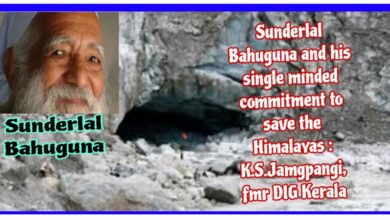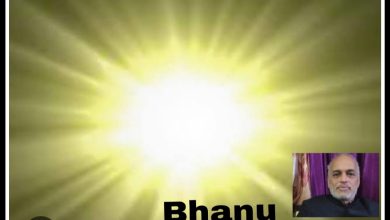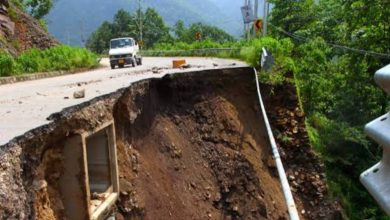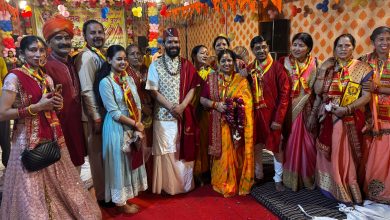Pauri in Garhwal, Uttarakhand : Serenely pristine !

By SURESH NAUTIYAL
Pauri is just an over-night journey from the national capital of Delhi. This includes some four-hour serpentine journey starting from the gateway of Garhwal, bubbling Kotdwara town. The direct bus service is also available from Delhi, but not dependable. For those who prefer a train journey, the last railhead is Kotdwara. From Kotdwara onwards, road journey is the only option to the town with fading British accent.
As soon as one reaches Bubakhal, near Pauri, the snow-peaked panorama begins to unfold. The unexpected comes to life with the gorgeously presiding Chaukhamba peak coming into view, in the timeless sublimity. The rustic fragrance in the cool breeze puts the four-hour jostling ride on the backburner of memory and impresses on the mind to quickly forget the constantly biri (indigenous brown cigarette) smoking fellow passengers on the public transport vehicle.
Pauri is also approachable from the holy towns of Rishikesh and Srinagar in the Garhwal region but the real adventure begins the moment one leaves behind Kotdwara and ascends towards Gumkhal or a place to be reached by circularly ascending the serpentine, slim and treacherous road, hence Ghoomkhal. The journey is upward from Kotdwara till Gumkhal. The downward journey to Satpuli from Gumkhal gives a sense of being skidded into any deep gorge forever. At the bottom of the range, river Nayar uplifts the depressed morale. But that comes not easily. One has to descend hundreds of feet before reaching Satpuli. The fair, slim and smart high cheek boned driver has to negotiate hundreds of sharp and virtually blind bends and multitude of kilometres to reach Satpuli, the stopover where one can have Garhwali flavoured lunch with a heavy dose of red-hot chilies and salt. However, the ambience is too crowded and it is better to look for some isolated food join on the way.
Satpuli, the small town of seven bridges (now a single bridge in existence) is on the left bank of the small river Nayar, one among those few rivers in the Central Himalaya that has non-glacial origin. In a devastating flood in 1951, the entire town was washed away with its bridges and everything. The memories of the flood still haunt those who were lucky enough to save themselves.
After Satpuli, Bubakhal is an important stop on way to Pauri, a few kilometres ahead. The small city is just a night’s journey away from Delhi.
German writer-philosopher Goethe rightly called Uttarakhand the holiest of the holies. What else a land of mythological abode of the Hindu pantheon could be termed. More importantly, where snow-capped peaks sit like white bearded saints in timeless transcendental meditation. There is no need to explain why millions of people set out on pilgrimage or travel to its mountains. The sacred Char-Dham Yatra or pilgrimage of Badarinath, Kedarnath, Yamunotari, and Gangotari is a life-long dream of the Hindu devout!
From the time immemorial, Himalaya has been attracting people from across the globe. This treasure trove of myth and magical lore has had a mystical fascination. The Garhwal part of Uttarakhand encompasses some of the most spectacular scenery on the earth. Garhwal, the land of 52 forts, is one of the five geographical zones of the mountainous and mighty Himalaya, known in Puranic texts as Kedarkhand.
The Kedarkhand has historical, archaeological, and cultural interests but religious and spiritual interests reign supreme. Full of legends and mythology, the land is closely associated with legendary heroes of Mahabharata. The Pandava Nritya, the dance of the legendary Pandavas of the Mahabharata period, is a household activity in most Garhwal villages. Many a religious or cultural festivities are incomplete without this dance-form, which is choreographed collectively in an improvised way, in a circular manner, by the side of fire. Drum player-cum-narrator stands in a corner explaining the episodes from the Mahabharata in prose and poetry forms quite in consonance with the beats of the dhol (drum) and the damaon (the drum-duo). The men-folk dance as if in trance and in the avatar of the Pandavas. They even enact the typical behaviour of individual characters from the epic. The women-folk and children or the major part of the audience.
Pauri is a land of silent leisure, adventures, and tranquil walks. A week out from Delhi gets one to this non-descript place, where mountains are in endless monologue. The town is one of the main urban areas in the Garhwal division of the new state. Set in a sylvan setting, Pauri is largely an obscure place for the outsiders. In fact, it is a destination for those who wish to get lost in an unknown place and do not want to be identified at all. The unexplored town against the snow-clad ranges spread on a large montainscape was a revenue collection centre during the British Raj. The whole area under its jurisdiction was called the British Garhwal, other half of the region being under the Rulers of the Tehri Principality. After the Chinese aggression of 1962, Garhwal was bifurcated into two districts and a new district of Chamoli was created. Not long ago, a third district, Rudraprayag, came into existence.
Today, Pauri has mushroomed in all directions but still remains dwarfed by the pine and deodar (cedar) trees. Basic amenities and facilities are also in existence. Perhaps, less exposure to the outside world has not allowed it to grow commercially the way it should have been. The result: A beautiful motorable stretch between Bubakhal and the hills of Kimkaleshwar is almost intact in its pristine glory. There are no bars, no fancy restaurants and no parlours in the town. The Messmore College and several other such buildings faintly remind of the British Raj days with their typical architecture. Dark saffron-clad buildings, camouflaged in pine groves, are dominated by large deodars. Now, the town effectively starts from Chopara village on Shrinagar road to the bottom of the Kimkaleshwar temple. Like all Indian hill stations, Pauri has its Mall, though not crowded by endless row of shops as is the situation in the over crowded Nainital and Mussoorie. The town is mainly divided into two market rows — the Upper Bazar and the Lower Bazar, both of them dominated by the migrant shopkeepers from the plains. Local presence in business is dismal, the reason being their preference for white-collar jobs in the plains.
From each of its sides, Pauri offers eyeball-to-eyeball contact with the majestic beauty of Himalaya in its labyrinth of wilderness, its dense forests of fragrant pines and deodars and blooming rhododendrons, besides rich flora and fauna. Though no traveler, no trekker and no book could ever describe all paths in these mountains, Pauri offers an exquisite feast of opportunities for the hiker. Three to four days are enough for treading the lazy paths. Danda-Ka-Nagraja is one such place where one can also pay obeisance to the temple deity. This holy place is for those who want to peel another layer further, trek another league farther.
Though Pauri has motorable roads in all directions, a slow and fresh stroll in the wee hours to Bubakhal can freeze one’s imagination like the blood in the body. The dream is come true even for those who are not regular walkers for the road is not steep. The road passes through oaks, rhododendrons, pines, deodars, shrubs, and plants of economic, medicinal, herbal, and aromatic value amidst impregnable silence. During summers and before winters, thousands of flowers bloom in the area. One can return to Pauri from Bubakhal by the time the Sun is bright and breakfast is ready. An uphill and steep walk takes one to the temple complex of Kimkaleshwar temple amidst the dense forest of oaks and rhododendrons and sporadic pines.
Here one has a real sense of uplift. Situated at a height of about 7,000 feet, the temple is an old Shiva shrine where a large number of sadhus and sanyasins reside. At the very threshold of the monastery, the rows of brass bells ring out when one touches one with the hand. In the midst of the complex, adorn the Lingam and Nandi, vehicle of Lord Shiva. A large-sized antique drum has disappeared lately. The drum was one of the main attractions of the monastery, where pupils take education in Sanskrit and religious studies.
The walk up to Kimkaleshwar is steep but gets smooth on the way down to Kandoliya via Ransi, where Asia’s highest stadium has come up, though in a dilapidated condition. The place, however, offers first-rate panoramic view of the Chukhamba in tranquillity. On the other side spreads the Valley of Gagwarsyun, full of villages, forests, and terraced field-rows. The peak in the adjacent is called Keenash, where Lord Yama or the God of Death is believed to have meditated.
Other peaks visible from Kimkaleshwar Math are Trishulkantha, Hathiparbat, Nandadevi (highest peak of Uttarakahnd), Triyugi Narayan, Gangotari ranges, Bhagirathi ranges, Swargarohini, Kedarnath, etc., as if standing in a straight row. Also, river Alaknanda, the main tributary of the might Ganga, looks like a blue serpent from this place.
On the sidelines is Kandoliya, strategically located in the midst of old and quiet deodars. A large field awaits here. Many a national leader have addressed large gatherings in the past. The night view of the surrounding areas from here is matchless by any standard.
The road emanating from Pauri and leading to Deoprayag, one of the holiest confluences for the Hindu devotees, is an experience of its kind. It is ideal for those trekkers who like to peep deeper into the countryside. As one ascends on the pucca road and turns on the forest of Dwaridhar or the Keenash Parbat, just four km from Pauri, brings one to the threshold of the panoramic Idwal Valley and face-to-face with the Chaukhamba peak in the distance as if sitting on a huge sea of clouds and mist and in ascetic meditation. The pucca road and existence of the telephone poles only provide for discordant notes.
Six km from Pauri bus station is the seat of Ghandyal, a local deity. It is also a good trek amidst pines in their glory. The temple structure is rocky and of the improvised nature but a flag on its head keeps fluttering in an atmosphere fit for contemplation. Sikookhal is yet another small stopover on the way. Khirsu, 19 km away from Pauri, is preceded by a large dense forest. If one starts trek from Chaubatta to Khirsu, it would give a strange feeling. The woods are very thick, dark, and lovely. The winds wild and things beautiful in abundance. The valley down is not visible from behind the thick woods. However, Khirsu is a place where one can spend days together in an absolute rural setting. A forest guest-house and a tourist lodge provide for the necessary shelter. The woods here almost through the year attract the tourists and the nature lovers as well as the rains. The deodars and pines make Khirsu unbeatable. The Himalayan ranges seem even closer from here. The sombre handsomeness of the place makes it different amidst the dense woods.
From the Chaukhamba Viewpoint, one can get lost in the mystery of the endless mountainscape. The scene is hypnotic that one may not get tired of gazing at the timeless peaks for hours together. On the left of Chaukhamba Viewpoint, lies the dense oak and rhododendron forest, below the Keenash Parbat, passing through which is a breezy experience and enabling one to play hide and seek with the beaming Sun. Oaks and rhododendrons flash past as one approaches a natural water source just at the bottom of the forest. The water is more refreshing than the best soft drink available in the cities. On this way, one comes across a place called Ghurdauri, a sort of race-course in old times. Now, an engineering college has come up there. From there, one can gaze endlessly at the Himalayan ranges in rows and the Alaknanda flowing in perpetual peace. A night view from this place is just enough to take one to the celestial heights!
A trek from Pauri to Kot village will put one amidst the deep rural setting. However, a solo trek can be the most rewarding walk possible. It can bring one almost mystically close to both land and people in a way impossible when traveling with a group. The area, called Sitonsyun Patti or Strip, is believed to have experienced massacres during the Gorkhyani or the terror rule of the Gorkhas. According to the history books, several villages experienced massacres in which the Gorkha aggressors did not even spare the children. Their spirits still haunt the people there when invoked in ritual offerings.
On the Pauri-Kot road, village of Deval is situated where ancient temple cluster is still in existence. The small cluster has several temples including that of Lakshmana of Ramayana fame and Lord Shiva. It is believed that the temple cluster was built in two parts — the first dating back to 12-13th century and the other in 18-19th century. On Pauri-Devaleshwar road, six km from Pauri, is seated a temple complex in the village of Balori. On the confluence of rivulets Randigaad and Kunda, the temple is in the Nagar style of architecture.
Devalgarh is on Pauri-Bughani road, some 48 km from Pauri. From archaeological point of view, the place is very important. The place is replete with temples, icons, and stories devoted to the deities. Once upon a time, the place was the capital seat of the rulers of Garhwal. Believed to be more than 700 years old, the temple complex houses temples of Gaura Devi, Rajrajeshwari, Lakshminarayan, Murli Manohar Dattatreya, Satyanarayan, and Kaal Bhairava. Also, the place is famous for the samdhis of the followers of the Nath sampradaya or cult. Rock inscriptions are also there. Sumari, one of the largest villages in Garhwal, also houses a temple cluster near its water source. Dating back to 11-12th century, the temple houses five images of Lakshminarayan, besides that of Surya, Maharshimardini Durga,Vishnu, etc.
The best seasons to visit Pauri and the surrounding areas are August to November and March to June. December to February is rather cold and July to August rainy and inhospitable. September and October are months for those in search of flowers and more flowers. The air is bracing and peaks glisten like diamonds.






